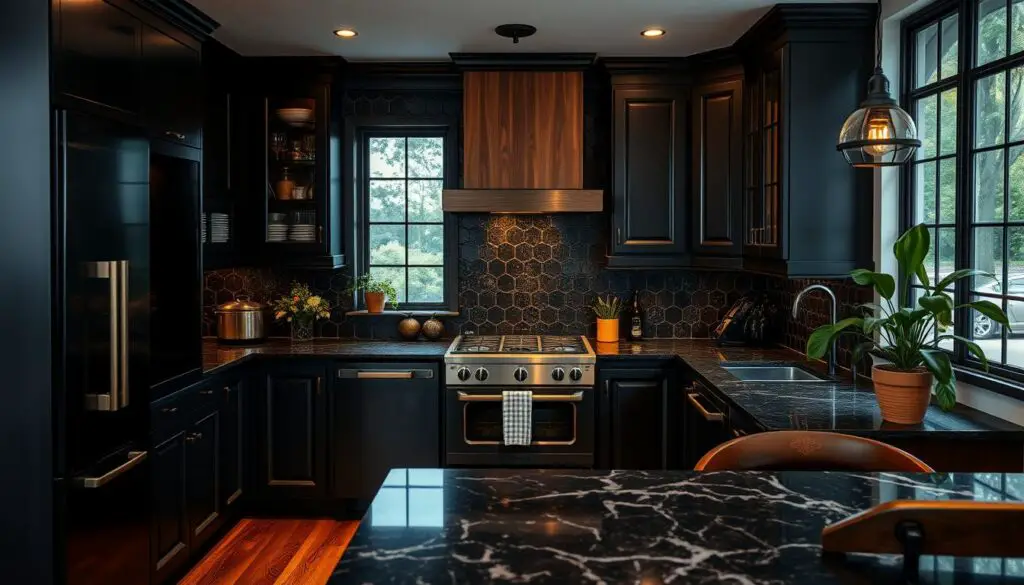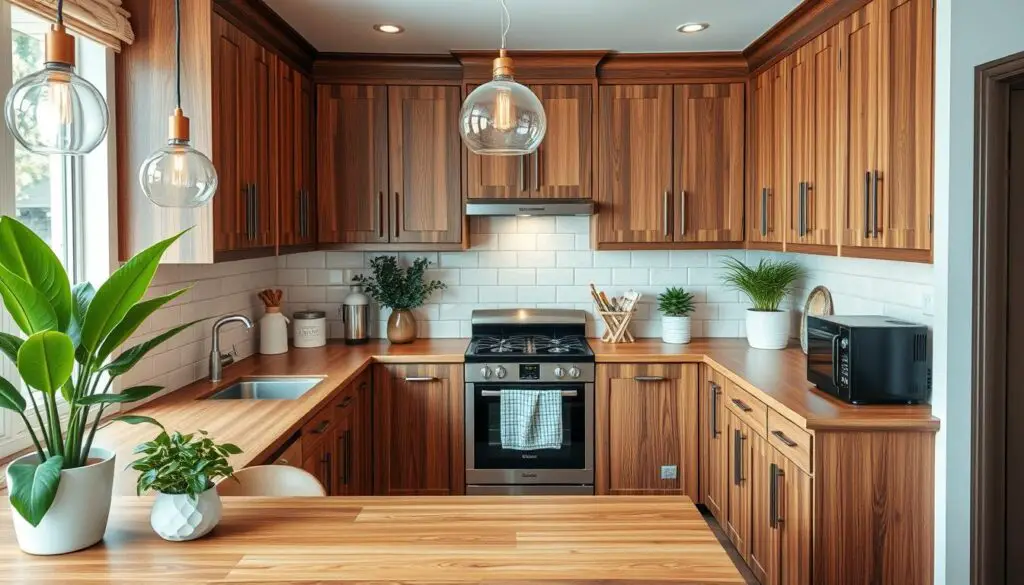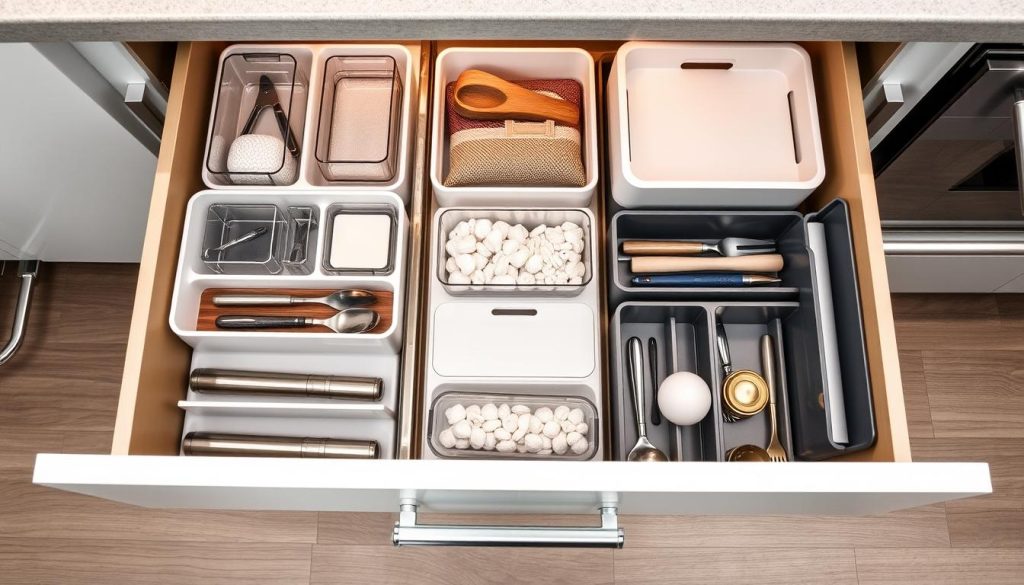
A cluttered kitchen can really stress you out, especially when you can’t find what you need. One great way to solve this problem is by using efficient drawer organization systems.
It’s important to make the most of your kitchen space. Drawer organization is key to doing this. By organizing your drawers well, you can make your kitchen easier for everyone to use.
This article will show you 20 creative ways to organize your drawers. We’ll cover everything from smart storage ideas to useful tips. Our goal is to help you make your kitchen more organized and functional.
Understanding Your Kitchen Drawer Needs
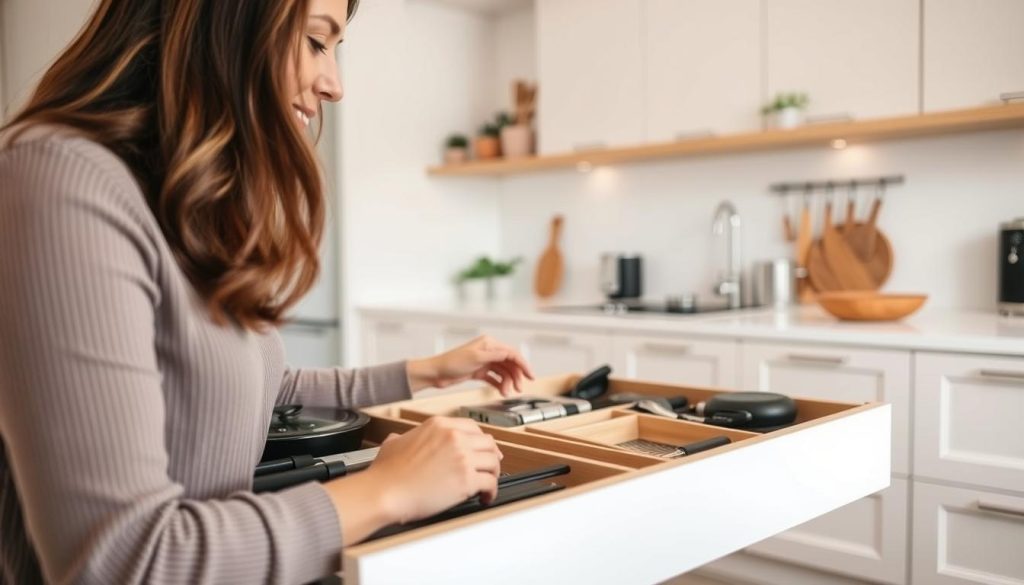
Before you start organizing your kitchen drawers, take a moment to assess your space and needs. This step is key to creating a plan that fits your kitchen’s layout and your personal style.
Assessing Your Space
Measuring your kitchen drawers is a must. Note their dimensions and any obstacles like plumbing or electrical parts. Think about your kitchen’s layout and how you move around. This will help you pick the right tools and strategies for organizing.
Identifying Key Items to Organize
Next, sort out the items you need to organize. Empty your drawers and group similar items together. You’ll find everything from cooking utensils to baking supplies and gadgets. Knowing what you have and how often you use it will guide your organization plan.
| Item Category | Frequency of Use | Organization Suggestion |
|---|---|---|
| Cooking Utensils | Daily | Easy-to-access drawer with dividers |
| Baking Supplies | Weekly | Designated drawer with bins for supplies |
| Cutlery | Daily | Cutlery tray or insert |
Understanding your kitchen drawer needs is the first step to a more efficient cooking space. This foundation is essential for effective organization solutions that maximize your space.
Essential Tools for Drawer Organization
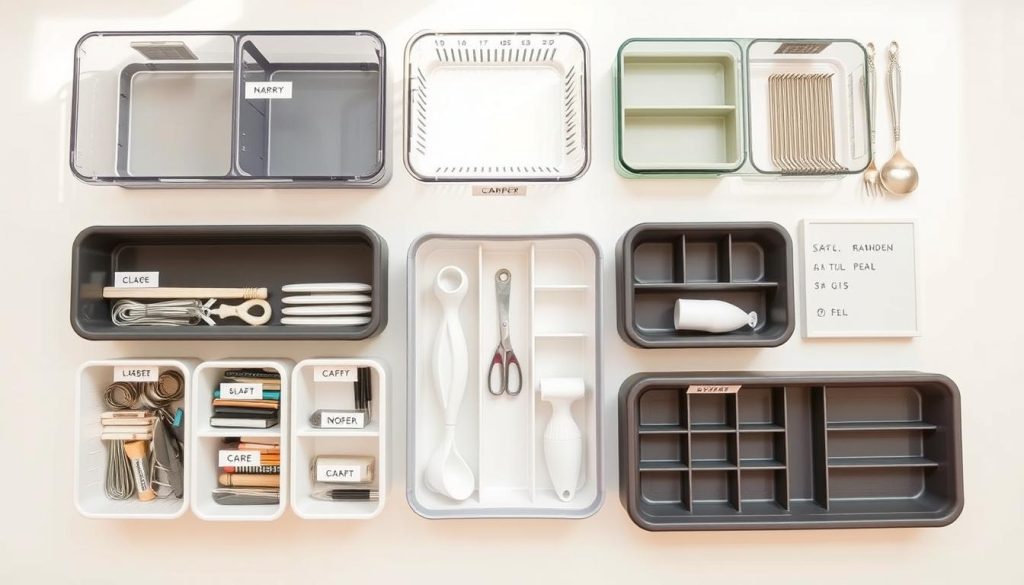
The key to a well-organized kitchen drawer is the tools you use. It’s not just about throwing things into a drawer. It’s about creating a system that makes your life easier.
To start, you’ll need a few essential tools to organize your kitchen drawers. These include drawer dividers, bins and containers, and labeling supplies. Let’s explore each category to see how they help.
Drawer Dividers
Drawer dividers are key to any drawer organization system. They separate items into sections, making it easier to find what you need. You can find dividers in materials like plastic, wood, or metal, in various sizes to fit your drawer.
- Adjustable dividers let you customize the space as needed.
- Fixed dividers offer a sturdy, permanent solution.
Bins and Containers
Bins and containers are vital for keeping drawers organized. They’re great for small items like utensils, spices, or baking supplies. Choose bins and containers based on your drawer’s size and the items you need to store.
Some popular options include:
- Stackable containers that save space.
- Clear containers that let you see what’s inside without opening them.
Labeling Supplies
Labeling supplies are the final step in organizing your drawers. They help you identify what’s inside each section or container. This makes it easier to keep things organized over time. You can use label makers or simple handwritten labels.
Labeling has several benefits:
- Ease of use: Quickly find out what’s inside a container or section.
- Maintenance: Encourages everyone to put things back in their spot.
By using these essential tools for your kitchen drawer organization, you’ll have a more efficient and stress-free cooking space. Whether you’re using DIY drawer organization hacks or creative drawer organization solutions, the right tools make a big difference.
The Best Drawer Dividers for Small Spaces
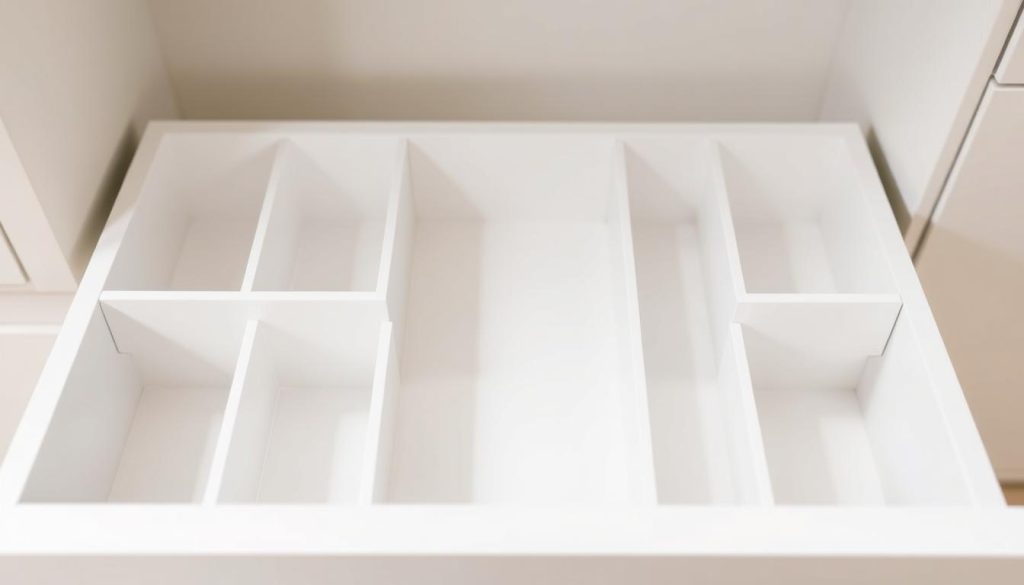
Drawer dividers are key for keeping kitchen drawers tidy in small spaces. They help sort items into groups. This makes your kitchen more organized and efficient.
Adjustable vs. Fixed Dividers
You can pick between adjustable and fixed dividers. Adjustable dividers let you change the layout as needed. Fixed dividers are better for drawers with the same items all the time.
DIY Dividers Using Cardboard
Using cardboard is a cheap way to make dividers. You can make them fit your drawer perfectly. Just cut the cardboard and put it in your drawer to start organizing.
Drawer dividers, whether adjustable, fixed, or DIY, help declutter your kitchen drawers. They make the most of your space.
Grouping Similar Items Together
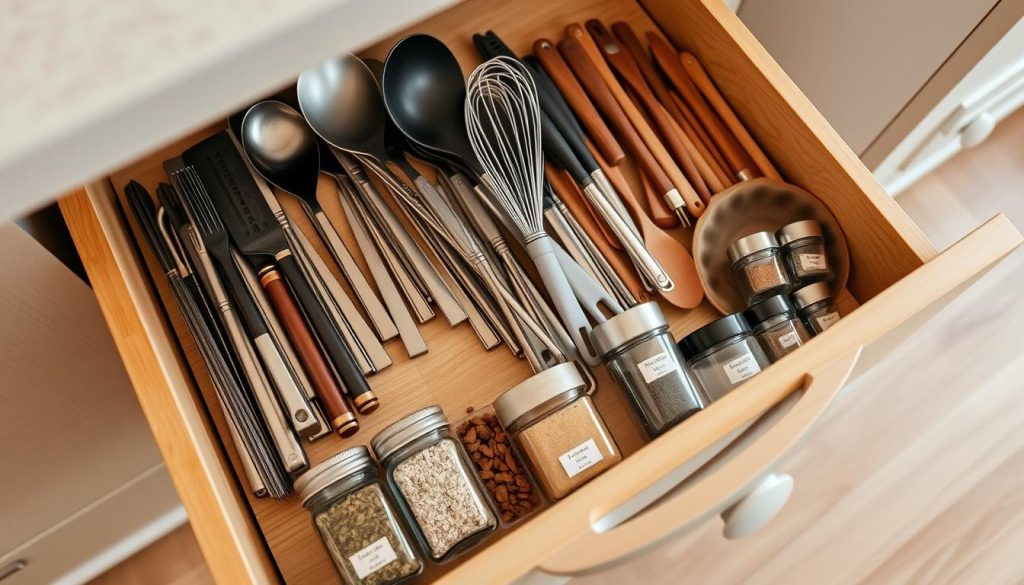
To make your kitchen better, group similar items together. This makes cooking easier and faster. It also helps you find what you need quickly.
Cooking Utensils
Choose a spot for your cooking tools. This includes spatulas, whisks, and spoons. Keeping them together saves time when you cook.
Baking Supplies
Store baking stuff like measuring cups, mixing bowls, and baking sheets together. This helps you plan and do baking tasks better.
Pantry Essentials
Group canned goods, spices, and grains in one place. This makes managing your pantry and meal planning easier.
Here’s how to organize your kitchen drawers by grouping similar items:
| Category | Items | Drawer Location |
|---|---|---|
| Cooking Utensils | Spatulas, Whisks, Spoons | Top Drawer |
| Baking Supplies | Measuring Cups, Mixing Bowls, Baking Sheets | Middle Drawer |
| Pantry Essentials | Canned Goods, Spices, Grains | Bottom Drawer |
This system leads to efficient drawer organization and smart use of small kitchen storage ideas. It makes your kitchen work better and cooking more fun.
Using Containers to Maximize Space
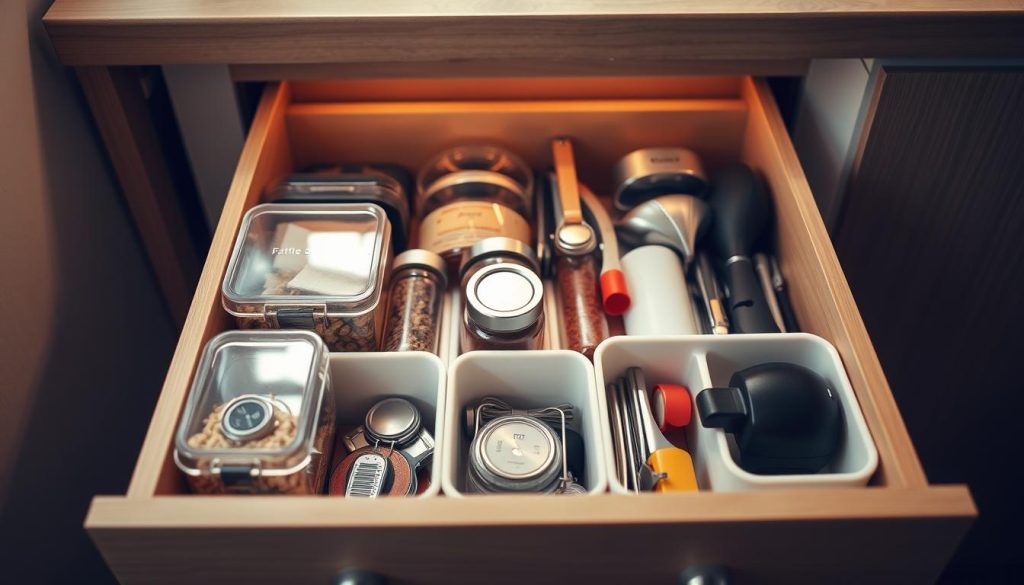
Containers are key to organizing kitchen drawers well. The right containers can greatly improve your kitchen drawer’s function.
Stackable Containers
Stackable containers are great for saving space in your kitchen drawers. They let you use the vertical space fully, keeping your drawers tidy. “Stackable containers are a game-changer for kitchen organization,” says a renowned kitchen design expert. They help you store utensils, spices, and cooking supplies neatly.
Clear vs. Opaque Options
You can choose between clear or opaque containers for your kitchen drawers. Clear containers let you see what’s inside easily. Opaque containers keep items that are not used often hidden, reducing clutter.
Choosing between clear and opaque depends on your needs and what you’re storing. Clear ones are good for spices or baking supplies. Opaque ones are better for gadgets you don’t use often.
Using containers in your kitchen drawer organization can make your cooking space more efficient. Experts say the secret to keeping drawers organized is to find a system that works for you and stick to it.
“The right containers can transform your kitchen drawers from cluttered to organized, making cooking and meal prep a breeze.”
Implementing a System for Cooking Tools
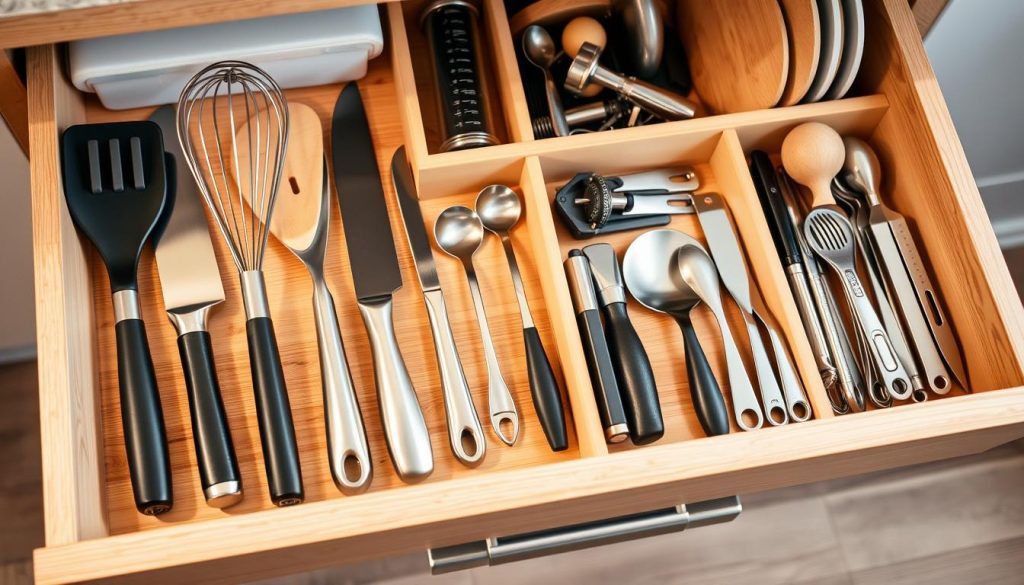
To make your kitchen more efficient, organizing cooking tools is key. A good system saves time and reduces clutter. This makes cooking more fun.
It’s important to keep tools accessible and safe. Sort them by how often you use them. This helps avoid damage and injury.
Organizing Spatulas and Spoons
Spatulas and spoons are used a lot in cooking. Organizing them well is essential. Use a divider or a special container in your drawer to keep them separate and easy to find.
A drawer divider can help organize spatulas and spoons. You can also use a utensil organizer with different compartments for each type of utensil.
“A place for everything, and everything in its place” is a mantra that applies perfectly to kitchen utensils. By assigning a home for each tool, you can maintain a clutter-free kitchen.
Storing Knives Safely
Knives are crucial but need careful storage. Bad storage can cause accidents and damage. Use a knife block or a magnetic strip on the wall or inside a cabinet door.
| Storage Method | Safety Features | Accessibility |
|---|---|---|
| Knife Block | Protects blades, prevents accidental cuts | Easy access |
| Magnetic Strip | Keeps knives off countertops, secure | Quick retrieval |
| Drawer Insert | Prevents knives from moving around | Convenient storage |
For space-saving kitchen drawer tips, think about a drawer insert for knives. It keeps knives organized and safe.
By following these tips, you can make your cooking tools more organized. Remember, keep your system up to date to stay efficient.
Clever Ways to Organize Spices
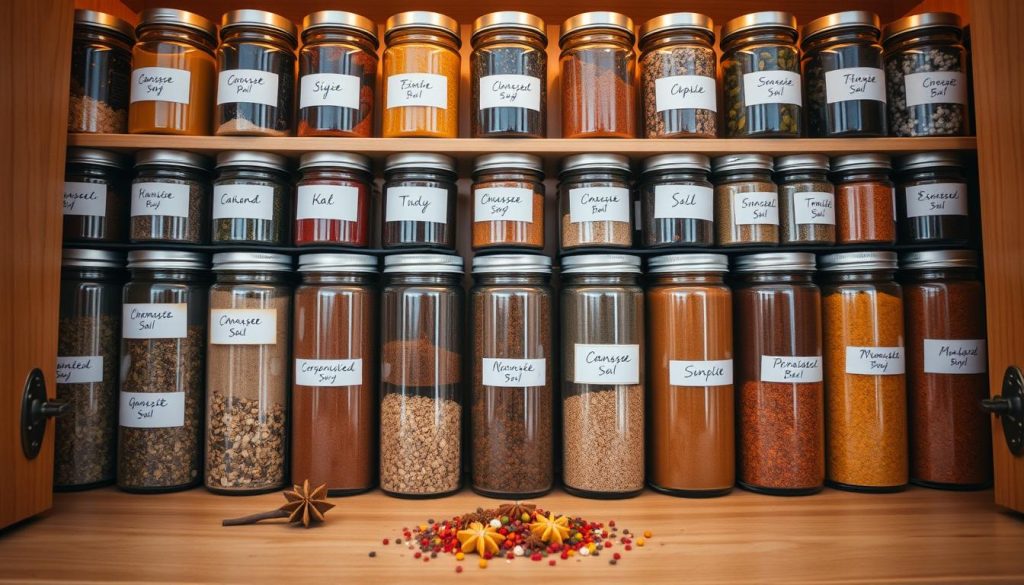
Organizing spices is a great way to start using your drawer space better. A messy spice collection can slow you down in the kitchen. By organizing your spices, you can make your kitchen more efficient and enjoyable.
Spice Racks vs. Drawer Inserts
There are two main ways to organize spices: spice racks and drawer inserts. Spice racks hang on walls or inside cabinets, making spices easy to see and grab. Drawer inserts, however, fit inside drawers and keep spices hidden.
Spice racks are perfect for those who like to see their spices. Drawer inserts are better for keeping countertops or walls tidy. Your choice depends on what you like and how your kitchen is set up.
Alphabetical vs. Category Arrangements
After picking your storage, decide how to arrange your spices. You can organize them alphabetically or by category. Alphabetical makes finding spices easy, especially if you have a lot.
Category arrangements group spices by use or type, like baking or international spices. This is great if you often cook certain cuisines.
| Arrangement Type | Advantages | Disadvantages |
|---|---|---|
| Alphabetical | Easy to locate specific spices | May not group related spices together |
| Category | Groups related spices together | May require more effort to locate a specific spice |
Think about your cooking habits and what you like when choosing how to arrange your spices. Whether you use a spice rack or drawer insert, and whether you organize alphabetically or by category, the goal is to make a system that works for you. This will help you maximize drawer space and declutter kitchen drawers.
Organizing Cutlery Efficiently
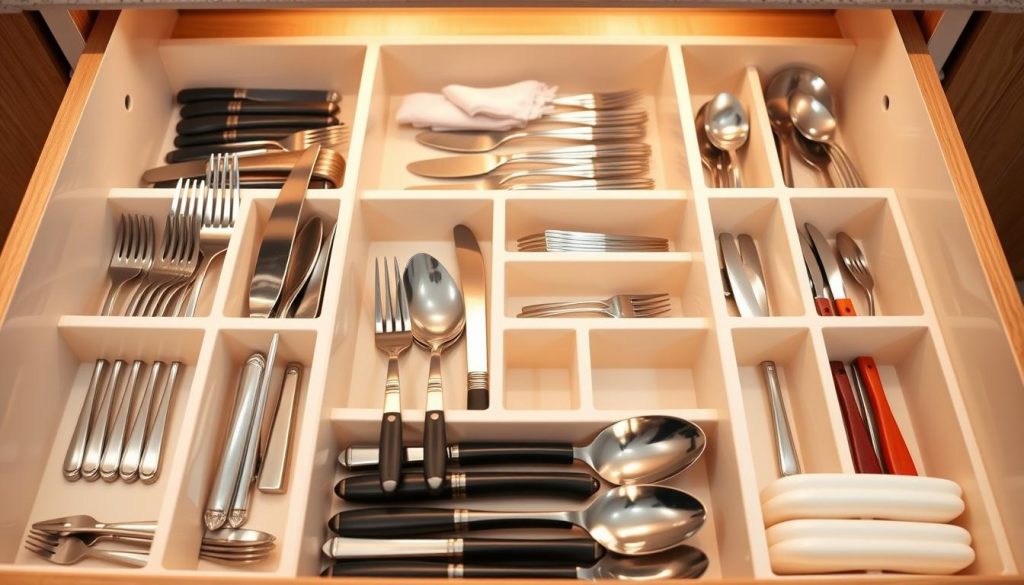
Organizing cutlery is more than tidying up. It’s about making your kitchen work better. When your cutlery is organized, cooking becomes easier and more fun.
Using drawer inserts specifically designed for cutlery is a great way to do this. These inserts keep your utensils in order and easy to find. This reduces clutter and makes your drawer space more useful.
Drawer Inserts for Cutlery
Drawer inserts for cutlery come in many designs. You can find simple dividers or complex ones with separate slots. Choose an insert that fits your needs and drawer size.
- Customizable inserts can be adjusted to fit different sizes of cutlery.
- Some inserts are designed with anti-slip materials to prevent utensils from moving around.
- Look for inserts with easy-to-clean surfaces to maintain hygiene.
Storing Specialty Knives
Specialty knives need special care. Storing them right protects the blades and keeps your kitchen safe.
Think about using knife blocks or magnetic strips in your drawer insert for these knives. This keeps them away from other utensils and prevents damage.
- Knife blocks can be integrated into your drawer insert for a compact solution.
- Magnetic strips can be attached to the side of the drawer or insert, holding knives securely in place.
By using these tips, you can make your drawers more organized. This improves your cooking and makes your kitchen a better place to be.
Maximizing Vertical Space in Drawers
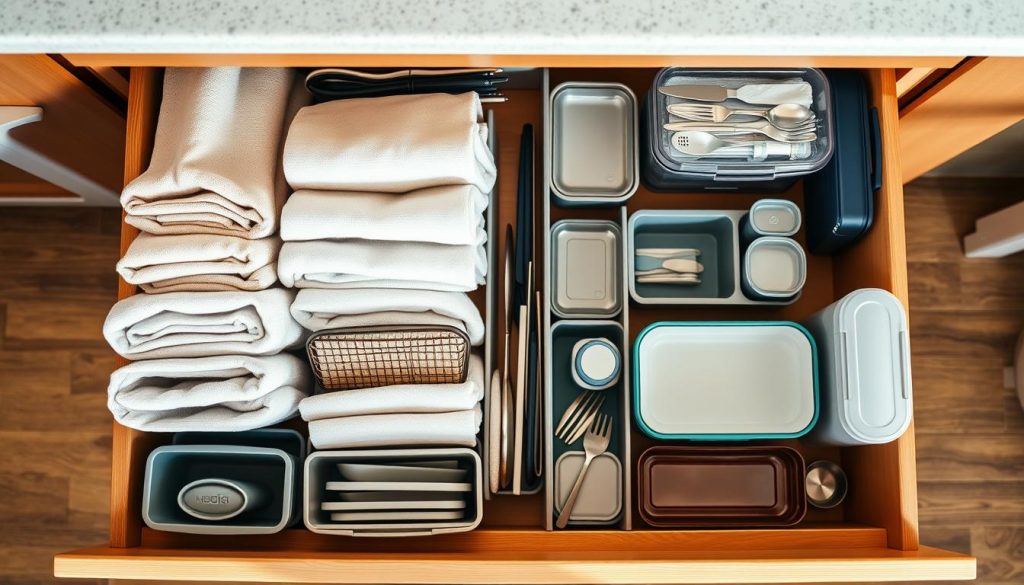
Using the vertical space in your drawers is a great way to organize your kitchen better. It lets you store more and use every inch wisely. This is especially helpful in small kitchens where space is limited.
Use of Tiered Organizers
Tiered organizers are perfect for making the most of your drawer’s height. They come in many styles, like stackable shelves and multi-level dividers. This way, you can sort and store things neatly.
Benefits of Tiered Organizers:
- Enhanced visibility of stored items
- Increased storage capacity
- Easier access to items
Incorporating Hooks or Racks
Adding hooks or racks to your drawers also helps use vertical space better. Hooks are great for hanging utensils, pot lids, or spices. Racks can hold baking sheets or trays, making the most of your drawer’s height.
“The key to a well-organized kitchen is not just about having enough storage, but also about making the most of the space you have.” – Kitchen Organization Expert
By mixing tiered organizers with hooks or racks, you can make your kitchen drawers super efficient. They’ll meet all your storage needs.
Creative Ideas for Dish Towels and Cloths
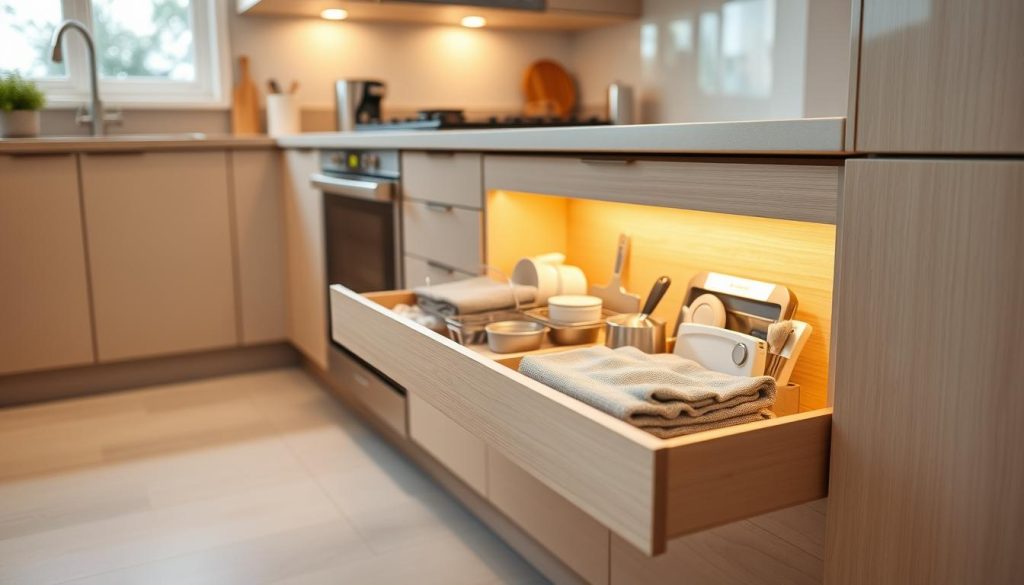
To make the most of your kitchen drawer, think creatively about dish towels and cloths. A tidy drawer not only looks good but also boosts kitchen efficiency.
Using folding techniques is a simple way to organize these items. A neat fold can significantly save drawer space.
Folding Techniques
Folding your towels and cloths can help you fit more in your drawer. Here are a few methods to try:
- The KonMari fold: This method folds the towel into a small rectangle that stands upright in your drawer.
- The roll: Rolling your towels reduces wrinkles and saves space.
- The bundle: Folding multiple cloths together into one bundle keeps them organized and easy to find.
Using Small Baskets
Small baskets are another great way to organize your towels and cloths. They can be placed inside your drawer to keep items separate and easy to find.
Here are some benefits of using small baskets:
| Benefit | Description |
|---|---|
| Easy Access | Baskets make it simple to grab what you need without having to dig through your entire drawer. |
| Organization | By separating items into different baskets, you can keep your drawer organized and clutter-free. |
| Aesthetics | Baskets can add a touch of warmth and style to your kitchen drawer. |
“A place for everything, and everything in its place.” – Benjamin Franklin
By using these DIY drawer organization hacks, you can make your cooking space more efficient and enjoyable. Whether you like folding or using baskets, there’s a method that suits you.
Organizing Miscellaneous Kitchen Gadgets
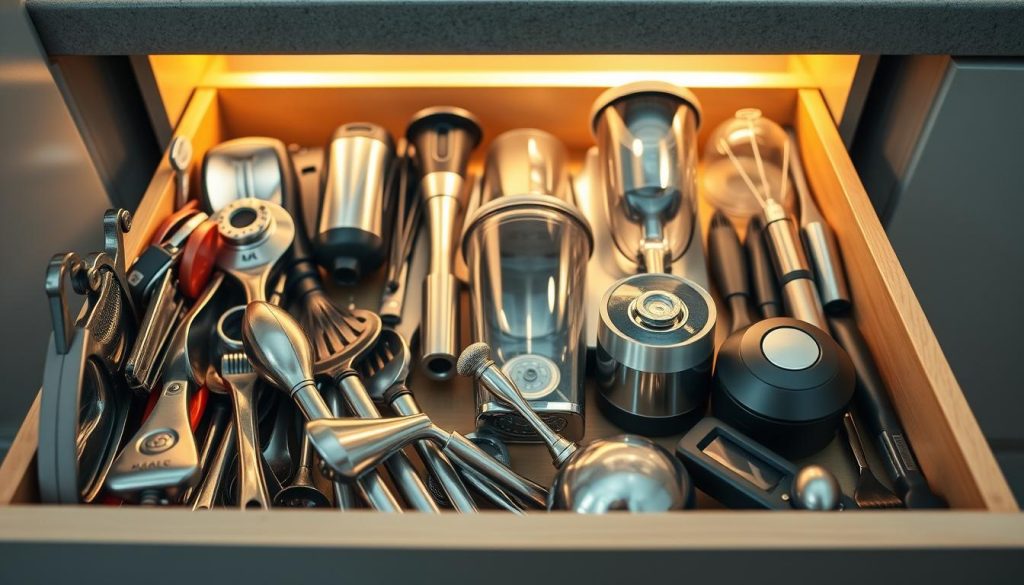
Miscellaneous kitchen gadgets can quickly clutter your drawers. But, with the right strategy, you can keep them organized. The key is to use your space wisely and make sure your gadgets are easy to find.
Grouping by Frequency of Use
One effective way to organize your gadgets is by grouping them by how often you use them. This lets you focus on the gadgets you use most. It makes them easier to find when you need them.
- Frequently Used Gadgets: Store these in easy-to-reach locations, such as the front of a drawer or in a convenient countertop container.
- Occasionally Used Gadgets: These can be stored in less accessible areas, such as deeper in a drawer or on a higher shelf.
- Rarely Used Gadgets: Consider storing these in a separate storage area or on a hard-to-reach shelf to free up space for more frequently used items.
Creating a “Toolbox” Drawer
Designating a specific drawer as a “toolbox” for your kitchen gadgets is a great strategy. This means setting aside a drawer for gadgets you don’t use often or for specific tasks.
To make the most of your “toolbox” drawer, use dividers or small containers. This keeps items organized and prevents clutter.
“A place for everything, and everything in its place” is a mantra that can greatly simplify your kitchen workflow.
By using these strategies, you can maximize your drawer space and declutter your kitchen drawers. This makes cooking and meal preparation more efficient and enjoyable.
Labeling for Easy Access
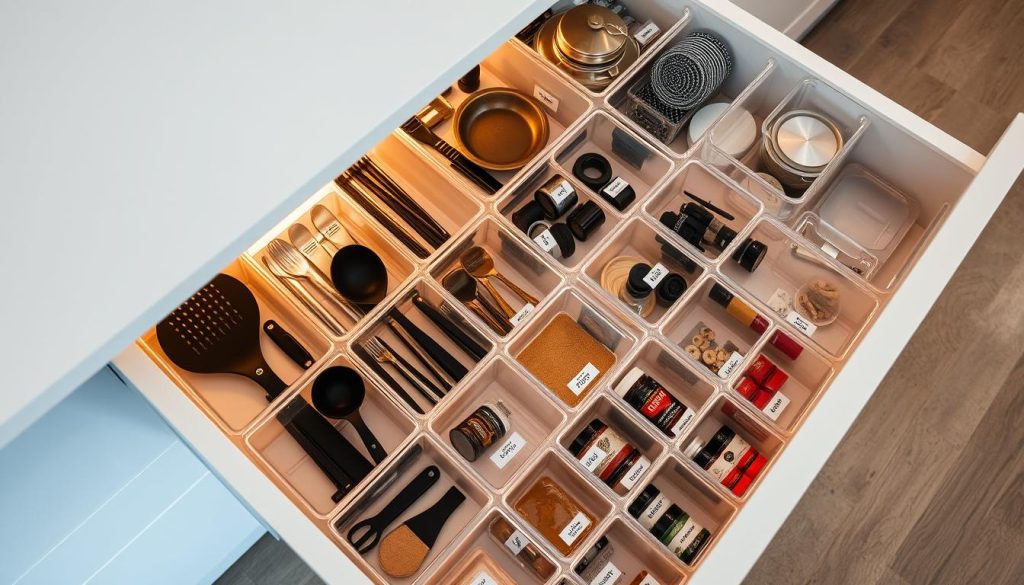
To make sure you can easily find your kitchen tools, labeling is crucial. It makes your drawer system work better and helps everyone in the house find what they need.
There are many ways to label your drawers. Your choice depends on what you like and your kitchen’s look. You can use a label maker or write your own labels.
Utilizing a Label Maker
A label maker is fast and makes labels look professional. It’s easy to read, even for those with vision problems. You can pick from different fonts and sizes to match your kitchen.
Handwritten Labels for a Personal Touch
Handwritten labels give your kitchen a personal feel. They can reflect your home’s unique style. They might not be as uniform as label maker labels, but they add a warm touch.
| Labeling Method | Advantages | Disadvantages |
|---|---|---|
| Label Maker | Uniform, professional look; easy to read | May lack personal touch; requires initial investment |
| Handwritten Labels | Personal touch; customizable | May be less legible; time-consuming |
Choosing between a label maker and handwritten labels depends on what you value most. If you want a neat, modern look, a label maker is best. For a cozy, personal touch, handwritten labels are ideal.
Regular Maintenance for Organized Drawers
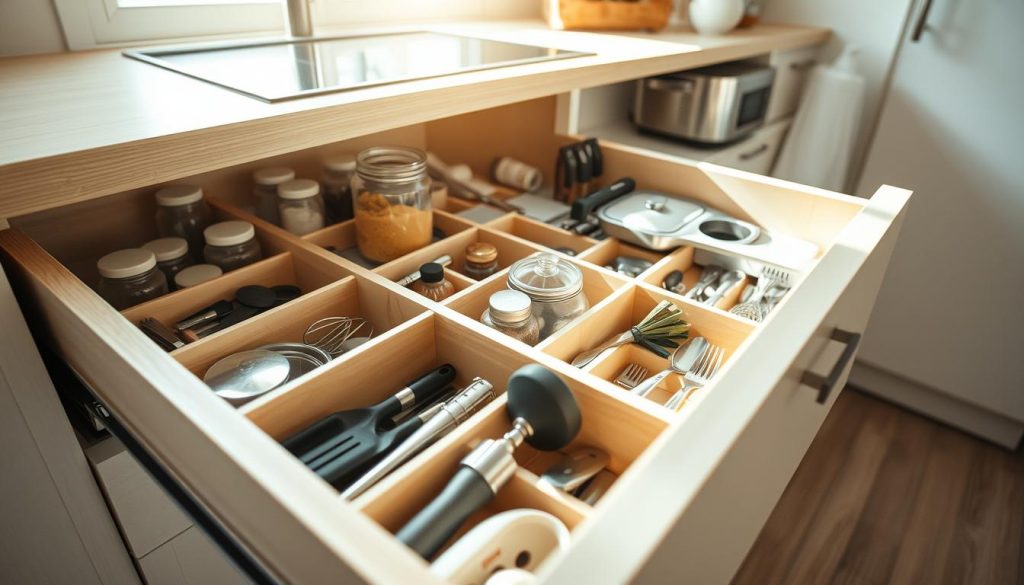
Keeping your kitchen drawers organized is a long-term effort. After setting up a system that works, it’s crucial to keep it up. This ensures your drawers stay organized over time.
Maintaining your drawers is more than just tidying up. It’s about keeping your organization system effective. This way, it continues to meet your needs.
Setting a Schedule
One effective way to keep your drawers organized is by setting a regular maintenance schedule. You might spend a few minutes each week tidying up. Or, you could set aside more time each month for a deeper clean.
This habit helps you catch disorganization early. It keeps your kitchen efficient and clutter-free.
When to Reassess Your Organization
Knowing when to reassess your organization system is key. Changes in your cooking habits or new gadgets can affect your system. So can changes in your household.
Regularly checking your drawer’s organization helps you spot what needs adjusting. This lets you make changes and keep your drawers optimized for your needs.
By maintaining regularly and reassessing often, you’ll keep your kitchen drawers organized. This makes cooking and meal prep more efficient and fun.
For more creative drawer organization solutions, explore different setups and tools. They can help you make the most of your drawer space.
Involving the Whole Family

Getting everyone involved in kitchen drawer organization is a great idea. It not only spreads out the work but also teaches kids important lessons. It’s a way to build teamwork and responsibility.
Teaching Kids to Help Organize
Teaching kids to help with kitchen drawer organization is rewarding for the whole family. Here are some tips to get you started:
- Start with simple tasks, such as sorting utensils or placing items in designated bins.
- Explain the importance of organization and how it makes cooking and meal prep easier.
- Make it a game by setting a timer and seeing who can organize their section the fastest.
- Praise their efforts and encourage them to take ownership of their tasks.
By involving kids, you’re teaching them a valuable skill. You’re also teaching them responsibility and teamwork.
Making it a Fun Family Activity
Turning kitchen drawer organization into a fun family activity is a great idea. Here are some ideas:
- Host a “drawer organization day” where everyone works together to declutter and organize the kitchen drawers.
- Play music or listen to a family favorite podcast while you work.
- Make it a competition to see who can come up with the most creative storage solution.
- Reward everyone’s hard work with a family dinner or outing.
By making it fun and collaborative, you create a positive experience. This approach not only helps with DIY drawer organization hacks. It also fosters unity and cooperation in maintaining your small kitchen drawer organization ideas.
Additional Tips for Long-Term Organization
To keep your kitchen drawers organized for a long time, you need a good plan. After trying out different ideas, it’s key to stay flexible and make changes when needed.
Staying Adaptable with Your System
Your kitchen’s needs can change, and your system should too. Be ready to rearrange your drawers as your needs shift. This way, they’ll always be useful to you.
Keeping a Few Extra Dividers on Hand
Having extra dividers or tools is smart. It helps when you need to adjust or add new gadgets. This keeps your drawers organized and working well.

